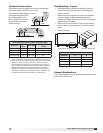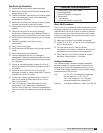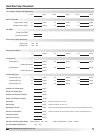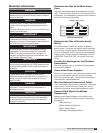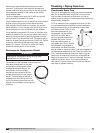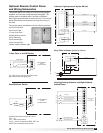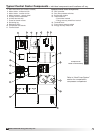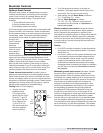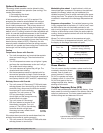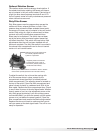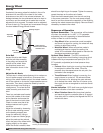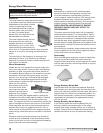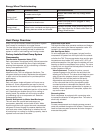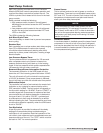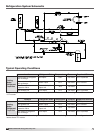
19
Model ERCH-HP Energy Recovery Unit
Electrical Controls
Optional Frost Control
Extremely cold outdoor air temperatures can cause
moisture condensation and frosting on the enthalpy
wheel. Frost control is an optional feature that will
prevent/control wheel frosting. Three options are
available:
1. Timed Exhaust frost control
2. Electric preheat frost control
3. Modulating wheel frost control
All of these options are provided with a thermostat (with
probe) mounted in the outdoor air intake compartment
and a pressure sensor to monitor pressure drop across
the enthalpy wheel. The typical temperature setting
corresponds to the indoor air relative humidity as
shown in the
Frost Threshold
Temperatures
table and
represents when
frost can occur.
An increase in
pressure drop
would indicate that frost is occurring. Both the pressure
sensor and the outdoor air temperature sensor must
trigger in order to initiate frost control. The two sensors
together ensure that frost control is only initiated
during a real frost condition. Field wiring of a light (or
other alarm) between 6 and C in the control center will
notify personnel when unit is in frost control mode.The
following explains the three options in more detail.
Timed exhaust frost control includes a timer in
addition to the thermostat and wheel pressure sensor.
When timed exhaust frost control is initiated, the timer
will turn the supply blower on and off to allow the warm
exhaust air to defrost the enthalpy wheel. Default factory
settings are 5 minutes off and 30 minutes on. Use the
following test procedure for troubleshooting.
Testing (refer to Timer diagram)
• Jumper the wheel
pressure switch
in the unit control
center. Set the Timer
Scale for T1 and T2
to 1 minute. Set the
Timer Settings for
T1 and T2 to 1.0.
Set the dip switch to
the down position.
(normal position)
Frost Threshold Temperatures
Indoor RH
at 70°F
Frost Threshold
Temperature
20% -10º F
30% -5º F
40% 0º F
A1 B1 15
16 18 A2
0.20
0.41.0
0.60.8
0.20
0.41.0
0.60.8
T1
T2
T21 MIN
T11 MIN
Timer
Scale
Dip
Switch
Timer
• Turn the temperature sensor up as high as
possible. The supply blower should cycle on for
one minute, then turn off for one minute.
• After testing, set the Timer Scale as follows:
T1 = 10 minutes, T2 = 1 hour
• Set the Timer Settings as follows:
T1 = 0.5, T2 = 0.5. The timer is now set for 5
minutes off and 30 minutes on. Remember to
remove the jumper.
Electric preheat frost control includes an electric
heater (at outdoor air intake) and an airflow pressure
switch (located at the preheater) in addition to the
thermostat and pressure sensor on wheel. When electric
preheat frost control is initiated, the electric preheater
will turn on and warm the air entering the energy wheel
to avoid frosting. Use the following test procedure for
troubleshooting.
Testing
• If no DDC controller is present, jumper thermodisc
and jumper the wheel pressure sensor. The heater
should turn on.
• If it doesn’t, either put the outdoor airside doors on
or temporarily jumper the airflow pressure switch
in the preheater control center to avoid nuisance
tripping of the pressure switch. Also check the
airflow switch pressure tap located at the supply
discharge blower to ensure the tubing is connected
and the tap is not blocked. Remember to remove
the jumpers.
Modulating wheel frost control includes a variable
frequency drive in addition to the thermostat and
pressure sensor. When modulating wheel frost control
is initiated, the variable frequency drive will reduce the
speed of the wheel. Reducing the speed of the energy
wheel reduces its effectiveness, which keeps the
exhaust air condition from reaching saturation, thus,
eliminating condensation and frosting. If the outdoor
air temperature is greater than the frost threshold
temperature OR the pressure differential is less than
the set point, the wheel will run at full speed. If the
outdoor air temperature is less than the frost threshold
temperature AND the pressure differential is greater
than the set point, the wheel will run at reduced speed
until the pressure differential falls below the set point.
The temperature and pressure differential set points are
set at the factory, but are field-adjustable. The variable
frequency drive will be fully programmed at the factory.



